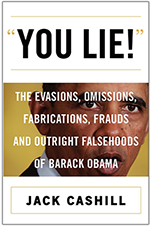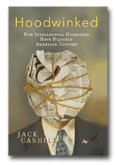What Ever Happened to
the Highway Shooter?
![]()
© Jack Cashill
Published in Ingramsonline.com - July 2014
On April 10 of this year, Kansas City made the national news in a way it had rather not. That was the day on which ABC’s Diana Sawyer shared the scary saga of the highway shooter who was then terrorizing Kansas City.
As Sawyer solemnly intoned, a deranged fellow had shot at as many as twenty cars on the highways south and east of Kansas City and already wounded three drivers. In one instance, a bullet had come within inches of a three year-old. This was one vengeful dude. Given the seriousness of the case, the FBI and the ATF had already joined the hunt for the suspect.
The ABC reporters compared the Kansas City shooter to a pair of snipers in the Washington, D.C., area who paralyzed the region for three weeks in 2002. The comparison was more apt than ABC knew, and it is the likely reason that the accused shooter, once arrested, figuratively fell off the radar as swiftly as Malaysia Airlines MH370 literally had a month earlier.
On the evening of April 17, the shootings again made the national news when Kansas City police apprehended the suspected shooter. As CNN reported, however, Police Chief Darryl Forte “declined to give a name for the suspect.”
On the next day, April 18, a month to the day after the spree started, Jackson County prosecutors named the accused shooter and announced eighteen felony charges against him. The New York Times, like most other national media, did report the arrest but did not even hint at what might have motivated the named shooter, 27 year-old Mohammed Pedro Whitaker.
The last serious article on the case, local or national, appeared in the Kansas City Star on April 20. The Star’s Christine Vendel related the details of the shootings and interviewed some of Whitaker’s Moberly High School classmates. “He was a pretty decent person. He was friends with everybody,” said one classmate, Lindsay Still Swoboda. The descriptions of Whitaker went no deeper than that.
As Vendel reported, “Authorities at Friday’s news conference said they knew of no motive.” She added, “They believe Whitaker acted alone and that he had little criminal record.” If Vendel made any effort to deduce a motive from the existing evidence, it was not apparent in the article.
Three days before Whitaker was arrested, Kansas City again made the news in an unfortunate way. On that rainy Sunday afternoon, a vestigial 73 year-old neo-Nazi named Frazier Glenn Cross went to the Jewish Community Center in Overland Park and shot and killed three people. An avowed anti-Semite, Cross could not have been pleased to learn that all three victims were Christians.
Following this shooting, the media did what media are supposed to do. Print and broadcast, local and national, the media swarmed Marionville, the southwestern Missouri town in which Cross lived and interviewed everyone who might have crossed paths with the accused killer.
Although Cross was something of an open book, there was no shortage of speculation on his motives, his allies, and his place in some larger national white supremacist movement.
The only thing that dampened media enthusiasm for the story was that Cross ran for Congress in 2006 against Roy Blunt as a Democrat.
Whitaker inspired no such interest. Although both men were routinely listed by their three given names, two months after their arrests “Mohammed Pedro Whitaker” was generating 28,000 hits on Google. “Frazier Glenn Cross” was generating nearly 1.6 million. “Frazier Glenn Miller,” a Cross pseudonym, was generating another 1.1 million. Whitaker had not even gotten a Wikipedia page.
The fact that Cross’s victims died had something to do with the disparity, but not much. Before Whitaker was identified by name, his actions had spawned widespread national coverage. This was not true of Cross, who was apprehended almost immediately after the shootings and about whom there was little mystery.
The disparity in coverage, I suspect, had less to do with the victims or intended victims than it did with identity of the shooter. Had Mohammed Pedro Whitaker done his shooting at the JCC the media would have been tempted to run from the story much as they did after his arrest for the highway shootings.
In the way of comparison, a month after the JCC shootings, 29-year-old French national Mehdi Nemmouche walked into the Jewish Museum of Belgium in Brussels and opened fire, killing four. Despite the international nature of his crime, this self-identified jihadist has generated about one-fourth the Google hits as Frazier Glenn Cross. The story only barely made the news in America.
For three weeks in 2002, a sniper paralyzed the District of Columbia, killing ten and wounding several more. After police finally arrested John Allen Muhammad and Lee Boyd Malvo, CNN’s Howard Kurtz asked the question of the day, “All those profiles of an angry white man, how did so many made-for-TV experts get it so wrong?”
Even after Muhammad and Malvo were arrested, the media did their damnedest to find a motive other than the obvious for the sniper killings. The fact that a man named “Muhammad” terrorized the nation’s capital six months after another man named “Mohamed” leveled the World Trade Center did not shake the media out its willful slumber. It took a series of exhibits at the pair’s trial--like the portrait of the two inscribed, "We will kill them all: Jihad”--to wake the media up.
Although I have read everything I could find on the case and called Whitaker’s public defender, I still have no idea why Whitaker did what he did. Nor do I know when or how he picked up the name “Mohammed.” To be sure, most people named Mohammed would do no such a thing, but if a person named “Mohammed” terrorizes your town, there is some cause for suspicion.
The local media with the resources to answer these questions have not even addressed them. The Cross case proved their capability to dig deep. They have chosen not to dig in the Whitaker case, I suspect, for fear of what they might find. Here too, as Howard Kurtz implied, the media are much more comfortable reporting on “angry white men.”




